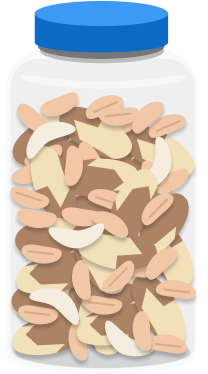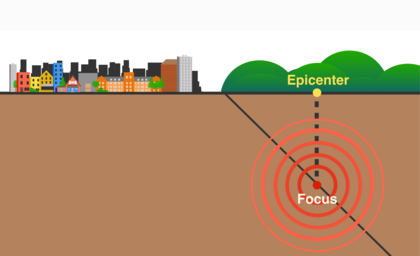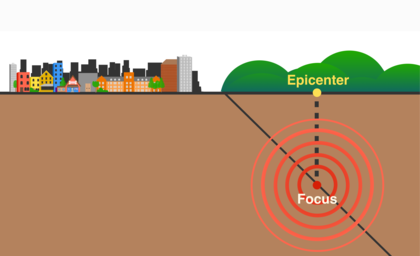
Granular Convection
A container with different-sized nuts, including large Brazil nuts, cashews, and peanuts, is packaged at a factory. When the nuts are first packaged, they are evenly distributed.
What will happen to the container of nuts over time if it is shaken?

Hint : Consider how cereal at the bottom of a bag compares to the cereal on top!
This section requires Javascript.
You are seeing this because something didn't load right. We suggest you, (a) try
refreshing the page, (b) enabling javascript if it is disabled on your browser and,
finally, (c)
loading the
non-javascript version of this page
. We're sorry about the hassle.
17 solutions
Moderator note:
Want to learn more? Check out our newest course, Waves and Light !
Preview what's next...


Noise-Canceling Headphones
Apply your knowledge of waves to understand how noise-canceling headphones work.
Seismic Waves
Explore earthquakes and seismic waves, and learn what seismographs can tell us about an earthquake.
Speed of Light
Determine how long it takes for light to reach Earth from the Sun, and learn how to calculate this for any place within the observable universe!
Your journey awaits!
Uncover the fundamental nature of light, explore the electromagnetic spectrum, and learn about how the speed of light limits the observable universe.




I feel that it could all be summed up using densities:
Shaking the container will put all the nuts in a sort of a "freefall" state, where they will be close to weightless. Therefore, since they will all have similar masses due to the near-weightlessness, the Brazil nuts, having the most volume, will be the least dense. Therefore, the Brazil nuts will sort of "float" to the top.
Log in to reply
Why would a Brazil nut be less dense necessarily? It could be argued though that the space used by the Brazilian nut is less dense.
Log in to reply
That is what is meant by this. The volume of the Brazil is greater than the peanut, but the masses would be decreased to the point where they are nearly equivalent.
Is the explanation correct?
As a matter of fact, this is the reason why bad cereal is at the bottom of the box.
Thank you for directing us to the terrific video!
That was really cool! Thanks for sharing.
So, how can this be useful in real life? The answer is: you could do this if you want to have the biggest nut.
Log in to reply
Never though Brilliant would be useful in more than just "education"
Lets first imagine that if big nuts settle at bottom then small nuts could seep through them but if one layer of small nuts settled it would not allow big nuts to seep through them. I guess it can be one of the reason.
I like this way of looking at it. It suggests that there are far more ways a small particle can work its way between larger particles than there is for large particles to work their way between small particles. Such indicates that the disorder of the system increases, or in other words, the entropy of the system increases. Thus, it represents the forward arrow in time, where more probably events occur.
Another analogy for sweeping through can be_ If you put sand, cherry-sized marbles, bigger rocks, put ‘n’ number of things, the finite sand will sweep through. Smaller things make way for themselves, they fit in between the gaps -any irregular shaped gap, the bigger things can’t so they take up the open space on the top.
Even as it seems complicated to explain why the Brazil nuts raise to the top, one can easily verify that the configuration where the larger nuts are on top and the smaller ones on the botton possesses an increasing gradient of density from top to bottom, assuming the materials are similar and the smaller ones pack more efficiently. Thus, this configuration has a lower energy state compared to the homogenous mix (as a greater fraction of the mass sits closer to the ground) and is more stable.
This is an interesting explanation and one I am sure my 10th grade physics students will appreciate
BS. The nuts are in the container, packed. Doesn't matter how you shake the container, the nuts are hardly being moved.
Log in to reply
Sorry? I don't see what you mean.
The question didn't say that the nuts are completely sealed tight.
The picture shows that they are not tightly packed. So there is space to move.
This makes soooo much sense thinking about it from the perspective of gradient density!!!! Thank you Lucas Viana!
As much as this explanation is very intuitive, I'm not sure it's right, I remember someone pointing out the mass/density are just a minor factor in the process and I think even if the big nut is heavier than the small ones it should jump up
Intuitively - When we shake, the smaller particles have more chance to go down easily between the gaps of larger ones. So smaller nuts end up at bottom
Stop copying questions from PBS's "It's Okay To Be Smart"!
Shaking increases the voids present between the particles. This causes easy seep in of the small particle, because of it being denser and upon action by the gravitational force.
Brazil nuts are bigger than smaller nuts so so if there was a layer of brazil nuts and a layer of smaller nuts, the smaller nuts potentially have a more likely chance of passing the gaps of the larger nuts
See, the nuts have spaces between them so if you shake them the smaller nuts will plummet through those spaces and will come at the bottom. And because of this the bigger nuts will come at the top. It is a bit oversimplified but if you are a beginner it is a good placeto start. This is called 'The Brazilian Nut' effect. Check out a video by Joe Hanson on his channel 'It's okay to be smart '.
Guys, don't overcomplicate it. Larger object just won't fit the hole, so it got hold up by objects that are below it while smaller objects can easily slide through to the bottom very easily, also Joe Hanson from It's Okay To Be Smart did a video about that on YouTube.
It’s called segregation,this happens due to different sizes, shapes and densities of the brazil nuts where the denser nut will accumulate and cake at the bottom
There's no generally accepted explanation, but a good one is that because of convection, the larger nuts are raised to the top
It is just like when you are eating chips and gradually you end with smaller and smaller pieces of the same and you want to get more! This can expain the answer of the question in a similar way.
Thank you
For example, If stones and sand are put in a jar unevenly, and if the jar is now shaken, the sand particles of lesser size will move through the gaps to the bottom (gravity playing the role of pulling the sand to the bottom).
A good big 'in will always come out on top over a good little 'un.
The big nuts. Let's first imagine that if big nuts settle at bottom then small nuts could seep through them but if one layer of small nuts settled it would not allow big nuts to seep through them. I guess it can be one of the reasons.
Poor question. Fact is that the most buoyant nuts will be work their way to thee top.
The ones of lesser weight will settle down when it is mixed.
This is known as the "Brazil nut effect", and is explained well in this video . There are several factors at play, but note that a change in the shape of the container to an inverted cone would actually reverse the effect, i.e., the Brazil nuts would end up on the bottom.